下载安装包安装或者pip都可以。
gpu版本我用的是python+Ubuntu+gpu,安装教程见:https://www.cdsy.xyz/computer/soft/develop/230327/cd42014.html
当然如果直接cpu版本,使用pip install dlib即可
windows下需要下载安装包,https://pypi.org/project/dlib/18.17.100/#files,找到你需要的安装包,然后pip install xxxx.whl即可。
任君挑选

上代码:
- # encoding:utf-8
-
- import dlib
- import numpy as np
- import cv2
-
- def rect_to_bb(rect): # 获得人脸矩形的坐标信息
- x = rect.left()
- y = rect.top()
- w = rect.right() - x
- h = rect.bottom() - y
- return (x, y, w, h)
-
- def resize(image, width=1200): # 将待检测的image进行resize
- r = width * 1.0 / image.shape[1]
- dim = (width, int(image.shape[0] * r))
- resized = cv2.resize(image, dim, interpolation=cv2.INTER_AREA)
- return resized
-
- def detect():
- image_file = "test.jpg"
- detector = dlib.get_frontal_face_detector()
- image = cv2.imread(image_file)
- image = resize(image, width=1200)
- gray = cv2.cvtColor(image, cv2.COLOR_BGR2GRAY)
- rects = detector(gray, 1)
- for (i, rect) in enumerate(rects):
- (x, y, w, h) = rect_to_bb(rect)
- cv2.rectangle(image, (x, y), (x + w, y + h), (0, 255, 0), 2)
- cv2.putText(image, "Face: {}".format(i + 1), (x - 10, y - 10), cv2.FONT_ HERSHEY_SIMPLEX, 0.5, (0, 255, 0), 2)
-
- cv2.imshow("Output", image)
- cv2.waitKey(0)
-
- if __name__ == "__main__":
-
- detect()
-
结果截图:

代码:
- # encoding:utf-8
-
- import dlib
- import numpy as np
- import cv2
-
- def rect_to_bb(rect): # 获得人脸矩形的坐标信息
- x = rect.left()
- y = rect.top()
- w = rect.right() - x
- h = rect.bottom() - y
- return (x, y, w, h)
-
- def shape_to_np(shape, dtype="int"): # 将包含68个特征的的shape转换为numpy array格式
- coords = np.zeros((68, 2), dtype=dtype)
- for i in range(0, 68):
- coords[i] = (shape.part(i).x, shape.part(i).y)
- return coords
-
-
- def resize(image, width=1200): # 将待检测的image进行resize
- r = width * 1.0 / image.shape[1]
- dim = (width, int(image.shape[0] * r))
- resized = cv2.resize(image, dim, interpolation=cv2.INTER_AREA)
- return resized
-
- def feature():
- image_file = "test.jpg"
- detector = dlib.get_frontal_face_detector()
- predictor = dlib.shape_predictor("shape_predictor_68_face_landmarks.dat")
- image = cv2.imread(image_file)
- image = resize(image, width=1200)
- gray = cv2.cvtColor(image, cv2.COLOR_BGR2GRAY)
- rects = detector(gray, 1)
- shapes = []
- for (i, rect) in enumerate(rects):
- shape = predictor(gray, rect)
- shape = shape_to_np(shape)
- shapes.append(shape)
- (x, y, w, h) = rect_to_bb(rect)
- cv2.rectangle(image, (x, y), (x + w, y + h), (0, 255, 0), 2)
- cv2.putText(image, "Face: {}".format(i + 1), (x - 10, y - 10), cv2.FONT_HERSHEY_SIMPLEX, 0.5, (0, 255, 0), 2)
-
- for shape in shapes:
- for (x, y) in shape:
- cv2.circle(image, (x, y), 2, (0, 0, 255), -1)
- cv2.imshow("Output", image)
- cv2.waitKey(0)
-
- if __name__ == "__main__":
-
- feature()
-
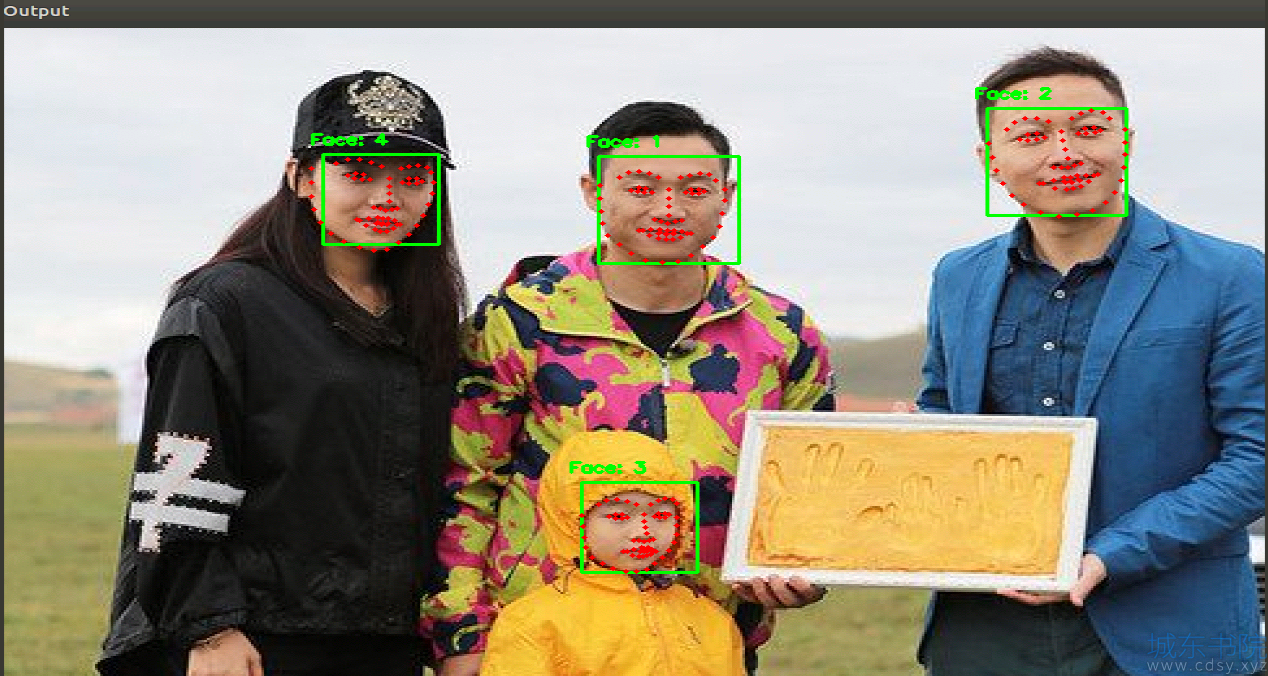
上代码:
- # encoding:utf-8
-
- import dlib
- import cv2
- import matplotlib.pyplot as plt
- import numpy as np
- import math
-
- def rect_to_bb(rect): # 获得人脸矩形的坐标信息
- x = rect.left()
- y = rect.top()
- w = rect.right() - x
- h = rect.bottom() - y
- return (x, y, w, h)
-
- def face_alignment(faces):
-
- predictor = dlib.shape_predictor("shape_predictor_68_face_landmarks.dat") # 用来预测关键点
- faces_aligned = []
- for face in faces:
- rec = dlib.rectangle(0,0,face.shape[0],face.shape[1])
- shape = predictor(np.uint8(face),rec) # 注意输入的必须是uint8类型
- order = [36,45,30,48,54] # left eye, right eye, nose, left mouth, right mouth 注意关键点的顺序,这个在网上可以找
- for j in order:
- x = shape.part(j).x
- y = shape.part(j).y
- cv2.circle(face, (x, y), 2, (0, 0, 255), -1)
-
- eye_center =((shape.part(36).x + shape.part(45).x) * 1./2, # 计算两眼的中心坐标
- (shape.part(36).y + shape.part(45).y) * 1./2)
- dx = (shape.part(45).x - shape.part(36).x) # note: right - right
- dy = (shape.part(45).y - shape.part(36).y)
-
- angle = math.atan2(dy,dx) * 180. / math.pi # 计算角度
- RotateMatrix = cv2.getRotationMatrix2D(eye_center, angle, scale=1) # 计算仿射矩阵
- RotImg = cv2.warpAffine(face, RotateMatrix, (face.shape[0], face.shape[1])) # 进行放射变换,即旋转
- faces_aligned.append(RotImg)
- return faces_aligned
-
- def demo():
-
- im_raw = cv2.imread('test2.jpeg').astype('uint8')
-
- detector = dlib.get_frontal_face_detector()
- gray = cv2.cvtColor(im_raw, cv2.COLOR_BGR2GRAY)
- rects = detector(gray, 1)
-
- src_faces = []
- for (i, rect) in enumerate(rects):
- (x, y, w, h) = rect_to_bb(rect)
- detect_face = im_raw[y:y+h,x:x+w]
- src_faces.append(detect_face)
- cv2.rectangle(im_raw, (x, y), (x + w, y + h), (0, 255, 0), 2)
- cv2.putText(im_raw, "Face: {}".format(i + 1), (x - 10, y - 10), cv2.FONT_HERSHEY_SIMPLEX, 0.5, (0, 255, 0), 2)
-
- faces_aligned = face_alignment(src_faces)
-
- cv2.imshow("src", im_raw)
- i = 0
- for face in faces_aligned:
- cv2.imshow("det_{}".format(i), face)
- i = i + 1
- cv2.waitKey(0)
-
- if __name__ == "__main__":
-
- demo()
-
-
示例一:
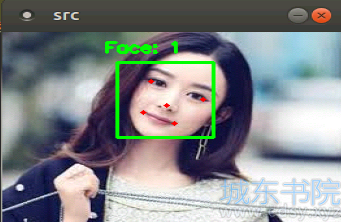
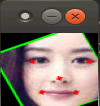
示例二:
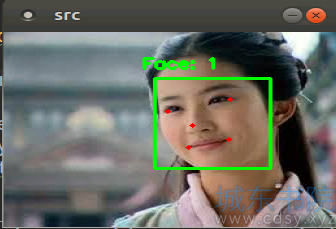

示例三:

这里我们不需要训练模型,因为已经有训练好的现成的模型了。只需要做一个验证。
准备测试数据,即图像对,两张图像为一个图像对,可以是同一个人,或者不同人,进行结果验证。
准备候选人数据,即我们数据库中有的人,此处为“赵丽颖”、“刘亦菲”、“刘诗诗”、“唐嫣”
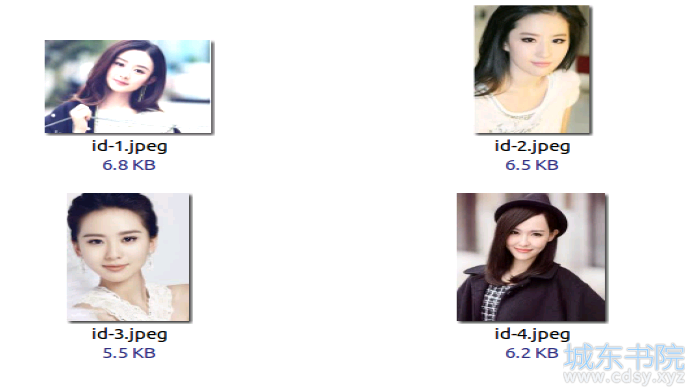
准备测试人数据,可以是数据库中有的人,也可以是没有的人,此处有6张测试数据,“赵丽颖”、“刘亦菲”、“刘诗诗”、“唐嫣”、“佟丽娅”、“杨紫”

上代码:
主要流程:
- # encoding:utf-8
-
- import dlib
- import cv2
- import matplotlib.pyplot as plt
- import numpy as np
- import math
- import os, glob
- from skimage import io
-
- def create_face_space():
-
- # 对文件夹下的每一个人脸进行:
- # 1.人脸检测
- # 2.关键点检测
- # 3.描述子提取
-
- # 候选人脸文件夹
- faces_folder_path = "candidate-faces/"
- # 候选人脸描述子list
- descriptors = []
- for f in glob.glob(os.path.join(faces_folder_path, "*.jpeg")):
- print("Processing file: {}".format(f))
- img = io.imread(f)
-
- # 1.人脸检测
- dets = detector(img, 1)
- print("Number of faces detected: {}".format(len(dets)))
-
- for k, d in enumerate(dets):
- # 2.关键点检测
- shape = sp(img, d)
-
- # 3.描述子提取,128D向量
- face_descriptor = facerec.compute_face_descriptor(img, shape)
-
- # 转换为numpy array
- v = np.array(face_descriptor)
- descriptors.append(v)
-
- return descriptors
-
-
- def predict(descriptors,path):
- # 对需识别人脸进行同样处理
- # 提取描述子
-
- img = io.imread(path)
- dets = detector(img, 1)
-
- dist = []
- for k, d in enumerate(dets):
- shape = sp(img, d)
- face_descriptor = facerec.compute_face_descriptor(img, shape)
- d_test = np.array(face_descriptor)
-
- # 计算欧式距离
- for i in descriptors:
- dist_ = np.linalg.norm(i-d_test)
- dist.append(dist_)
- return dist
-
- def demo():
- global detector, sp, facerec
- # 加载正脸检测器
- detector = dlib.get_frontal_face_detector()
-
- # 加载人脸关键点检测器
- sp = dlib.shape_predictor("shape_predictor_68_face_landmarks.dat")
-
- # 3. 加载人脸识别模型
- facerec = dlib.face_recognition_model_v1("dlib_face_recognition_resnet_model_v1.dat")
-
- descriptors = create_face_space()
- # 候选人名单
- candidate = ['zhaoliying', 'liuyifei',
- 'liushishi', 'tangyan',
- 'tongliya', 'yangzi']
-
- predict_path = "test--faces/"
- for f in glob.glob(os.path.join(predict_path, "*.jpeg")):
- dist = predict(descriptors, f)
- # 候选人和距离组成一个dict
- c_d = dict(zip(candidate, dist))
-
- cd_sorted = sorted(c_d.iteritems(), key=lambda d:d[1])
- print "The person_{} is: ".format(f),cd_sorted[0][0]
-
- if __name__ == "__main__":
-
- demo()
-
-
结果:
其中,只用赵丽颖被正确识别出来。
在已有数据库的刘亦菲被识别为刘诗诗,刘诗诗被识别为唐嫣,唐嫣被识别为刘亦菲
未在数据库中的佟丽娅被识别为刘亦菲,杨紫被识别为唐嫣


